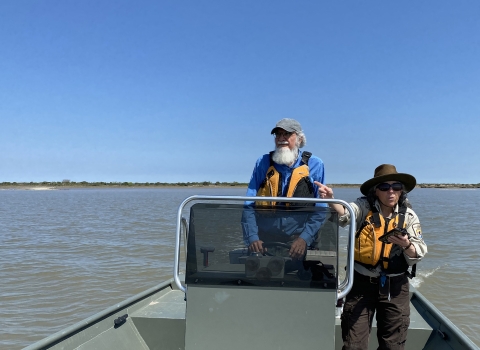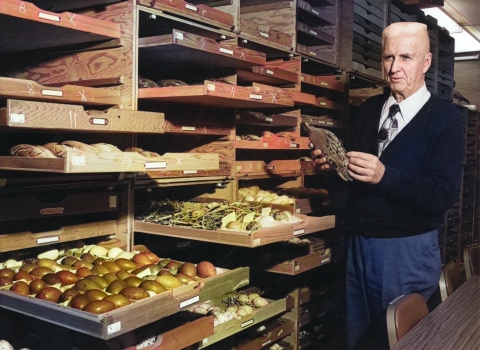Record of Decision for Sheldon National Wildlife Refuge's Management Plan Now Available
The U.S. Fish and Wildlife Service today announced its record of decision to implement the Sheldon National Wildlife Refuge’s Comprehensive Conservation Plan. A notice of availability for this decision was published in today’s issue of the Federal Register. Sheldon NWR spans Washoe and Humboldt Counties in Nevada and Lake County in Oregon. It is a part of the Sheldon-Hart Mountain National Wildlife Refuge Complex.
The CCP is a 15-year management plan for improving habitats within Sheldon NWR for the long-term conservation of fish, wildlife and plants and for providing wildlife-dependent recreation, environmental education and interpretation opportunities for refuge visitors.
The selected management alternative calls for various actions including: removal of feral horses and burros from the refuge, designation of vehicle routes for public use, recommendation for 351,598 acres to be designated as wilderness by Congress and development of existing visitor facilities such as campgrounds, interpretive trails and the visitor contact station.
“One of the refuge’s most important issues is restoring the degraded wildlife habitat conditions caused by feral horse and burro populations,” said John Kasbohm, Project Leader for Sheldon-Hart Mountain NWRC.
Feral horses and burros are not native to Sheldon NWR and cause considerable damage to native habitats by over-grazing and trampling fragile vegetation, stream beds and other wildlife resources. Results from ongoing research indicate both riparian riparian
Definition of riparian habitat or riparian areas.
Learn more about riparian and upland habitats are impacted by feral horses and burros. The Service examined habitat monitoring data obtained in 2002 and concluded that 44 percent of the refuge’s streams and 80 percent of its springs are severely degraded by feral horses and burros.
The cost of managing feral horses and burros is substantial and results in fewer funds and staff to support the refuge’s purposes and conservation mission.
“Managing the refuge’s feral horse and burro populations is required to limit damage to wildlife habitat,” Kasbohm said. “In the final plan, we propose to restore native habitats and species and lower long-term operating costs by removing all feral horses and burros from the refuge within five years.”
Removal of the feral horses and burros would occur primarily through roundups and private adoption.
The 575,000 acre refuge was established to conserve pronghorn antelope and other native species of the sagebrush sagebrush
The western United States’ sagebrush country encompasses over 175 million acres of public and private lands. The sagebrush landscape provides many benefits to our rural economies and communities, and it serves as crucial habitat for a diversity of wildlife, including the iconic greater sage-grouse and over 350 other species.
Learn more about sagebrush steppe ecosystem, such as pygmy rabbits, American pika, Greater sage-grouse and prairie falcons and other migratory birds. Most of the refuge’s lands are located in northern Nevada, with a small area in southern Oregon. In the semi-arid environment of this area, the refuge’s fish and wildlife species rely on its valuable but limited water resources and adjacent meadows, wetlands and riparian zones, which are impacted by feral horses and burros year-round but most severely during late-summer and mid-winter.
The Service invited public comments on the draft CCP and its associated environmental impact statement in September 2011 and received suggestions for improving the refuge’s habitat conservation and recreation programs. In response to public comment, the CCP and EIS were revised. The Service announced availability of the final CCP and EIS in August 2012, after which no substantive changes were made. The final decision for the Sheldon CCP was issued on September 27, 2012, following a 30-day review period.
The Sheldon NWR CCP and Record of Decision are available on the refuge’s website: www.fws.gov/pacific/planning/main/docs/NV/docssheldon.htm
Printed copies of the CCP are available at public libraries in Lakeview, Ore., Alturas, Calif., and Winnemucca and Reno, Nev.
Requests for a CD-ROM copy of the CCP can be submitted via e-mail to FW1_Sheldon_CCP@fws.gov or by U.S. mail to: John Kasbohm, Project Leader, Sheldon-Hart Mountain National Wildlife Refuge Complex, P.O. Box 111, Lakeview, OR, 97630.
The CCP is a 15-year management plan for improving habitats within Sheldon NWR for the long-term conservation of fish, wildlife and plants and for providing wildlife-dependent recreation, environmental education and interpretation opportunities for refuge visitors.
The selected management alternative calls for various actions including: removal of feral horses and burros from the refuge, designation of vehicle routes for public use, recommendation for 351,598 acres to be designated as wilderness by Congress and development of existing visitor facilities such as campgrounds, interpretive trails and the visitor contact station.
“One of the refuge’s most important issues is restoring the degraded wildlife habitat conditions caused by feral horse and burro populations,” said John Kasbohm, Project Leader for Sheldon-Hart Mountain NWRC.
Feral horses and burros are not native to Sheldon NWR and cause considerable damage to native habitats by over-grazing and trampling fragile vegetation, stream beds and other wildlife resources. Results from ongoing research indicate both riparian riparian
Definition of riparian habitat or riparian areas.
Learn more about riparian and upland habitats are impacted by feral horses and burros. The Service examined habitat monitoring data obtained in 2002 and concluded that 44 percent of the refuge’s streams and 80 percent of its springs are severely degraded by feral horses and burros.
The cost of managing feral horses and burros is substantial and results in fewer funds and staff to support the refuge’s purposes and conservation mission.
“Managing the refuge’s feral horse and burro populations is required to limit damage to wildlife habitat,” Kasbohm said. “In the final plan, we propose to restore native habitats and species and lower long-term operating costs by removing all feral horses and burros from the refuge within five years.”
Removal of the feral horses and burros would occur primarily through roundups and private adoption.
The 575,000 acre refuge was established to conserve pronghorn antelope and other native species of the sagebrush sagebrush
The western United States’ sagebrush country encompasses over 175 million acres of public and private lands. The sagebrush landscape provides many benefits to our rural economies and communities, and it serves as crucial habitat for a diversity of wildlife, including the iconic greater sage-grouse and over 350 other species.
Learn more about sagebrush steppe ecosystem, such as pygmy rabbits, American pika, Greater sage-grouse and prairie falcons and other migratory birds. Most of the refuge’s lands are located in northern Nevada, with a small area in southern Oregon. In the semi-arid environment of this area, the refuge’s fish and wildlife species rely on its valuable but limited water resources and adjacent meadows, wetlands and riparian zones, which are impacted by feral horses and burros year-round but most severely during late-summer and mid-winter.
The Service invited public comments on the draft CCP and its associated environmental impact statement in September 2011 and received suggestions for improving the refuge’s habitat conservation and recreation programs. In response to public comment, the CCP and EIS were revised. The Service announced availability of the final CCP and EIS in August 2012, after which no substantive changes were made. The final decision for the Sheldon CCP was issued on September 27, 2012, following a 30-day review period.
The Sheldon NWR CCP and Record of Decision are available on the refuge’s website: www.fws.gov/pacific/planning/
Printed copies of the CCP are available at public libraries in Lakeview, Ore., Alturas, Calif., and Winnemucca and Reno, Nev.
Requests for a CD-ROM copy of the CCP can be submitted via e-mail to FW1_Sheldon_CCP@fws.gov or by U.S. mail to: John Kasbohm, Project Leader, Sheldon-Hart Mountain National Wildlife Refuge Complex, P.O. Box 111, Lakeview, OR, 97630.


